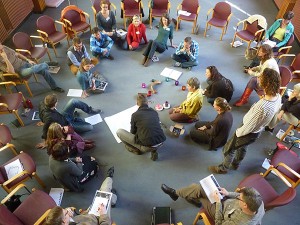Methods
Each of the methodologies used as part of the Art of Hosting has a powerful question at its core. Crafting a good question is a challenge and creating a great one is an art. It’s worth spending time on our questions because they open the door to whatever comes next. Here’s some good reading on the Art of Powerful Questions…
Here are some of the best known methods that the Art of Hosting uses:
THE CIRCLE WAY
The circle is the basic form underlining all other forms of participatory process. In every type of organization or group, we meet in circles (even if they are around a boardroom table) to plan for the future, handle crisis, and listen to each other. In the Art of Hosting practice we often begin and end meetings in a circle – it helps the process if participants can “check in” at the beginning about why they are participating, and “check out” at the end by reflect on what we’ve accomplished. Meeting in circle can be especially helpful when getting to know each other and the issue at hand, or as a means for deep reflection or consensus making. Learn more about The Circle Way here…
WORLD CAFÉ
World Café got its name because it imitates a café setting where small groups (4 or 5 people) are all conversing together around tables. In this case, a cluster of small groups – anywhere from 10 to 1000 – are in conversation about an issue that matters to them or some work they are trying to do together. It is an ideal way to find out what a community is thinking and feeling about a topic. After the first conversation, someone stays at the table as ‘host’, while the others move to a new table, taking their previous conversations with them. In this way, the threads of the various conversations are woven together and all of us get a sense of what is being discovered and developed between us. Learn more about World Café here…
OPEN SPACE TECHNOLOGY
When we want to harness the power of a group – especially a diverse one with many interests and skills – to meet a present challenge, Open Space Technology is the method we choose. Whenever we need the contribution and innovative genius of everyone – because a competitor has just entered the market, or we need to drastically overhaul our operations, or there is a crisis at the manufacturing plant, or we want to break down the silos within the business, or our community needs to create a strategic plan for its future. Convened around a core calling question, the group is made aware of any givens – budget, leadership, etc. – and then the space is opened for anyone to pose a session topic. Over the course of the meeting, people are free to choose which session(s) they most want to attend, bringing maximum enthusiasm and commitment for conversation and action. Personal buy-in and committed action can be achieved in a remarkably short time. Learn more about Open Space Technology here…
APPRECIATIVE INQUIRY
Instead of taking a problem-solving approach, Appreciative Inquiry offers a possibility focus, a move from “what is” to “what could be”. Based on a powerful, affirmative question, people interview each other to uncover experiences that resemble what we want to create. For example, if the challenge is teams not working well together, we might inquire into times when teams have been both collaborative and successful at the same time. Such experiences hold the keys to how we might bring about the future we’re visioning. In the Art of Hosting, we use Appreciative Inquiry to tap into the latent capabilities of the group to create the success they’re seeking.
Learn more about Appreciative Inquiry here…
The Art of Hosting is always evolving, bringing in complementary methods and creating new methods that further enhance the quality of conversations we host.
Some of the other methods we use are:
- Action learning
- Collective mind-mapping
- Collective Story Harvest
- ProAction Café
- Graphic Facilitation

If I had an hour to solve a problem and my life depended on the solution, I would spend the first 55 minutes determining the proper question to ask, for once I know the proper question, I could solve the problem in less than 5 minutes.
I recently decided to use the circle in a troubled space and the circle held us beautifully. Seven of us met for a half day, with the intention of simply getting unstuck and back on track. Afterwards, the boss and I, plus the two who had previously not been speaking to each other, went to lunch together. There was an atmosphere of relief, bordering on euphoria for some.” Read more about this story here.